Page 334 of 481
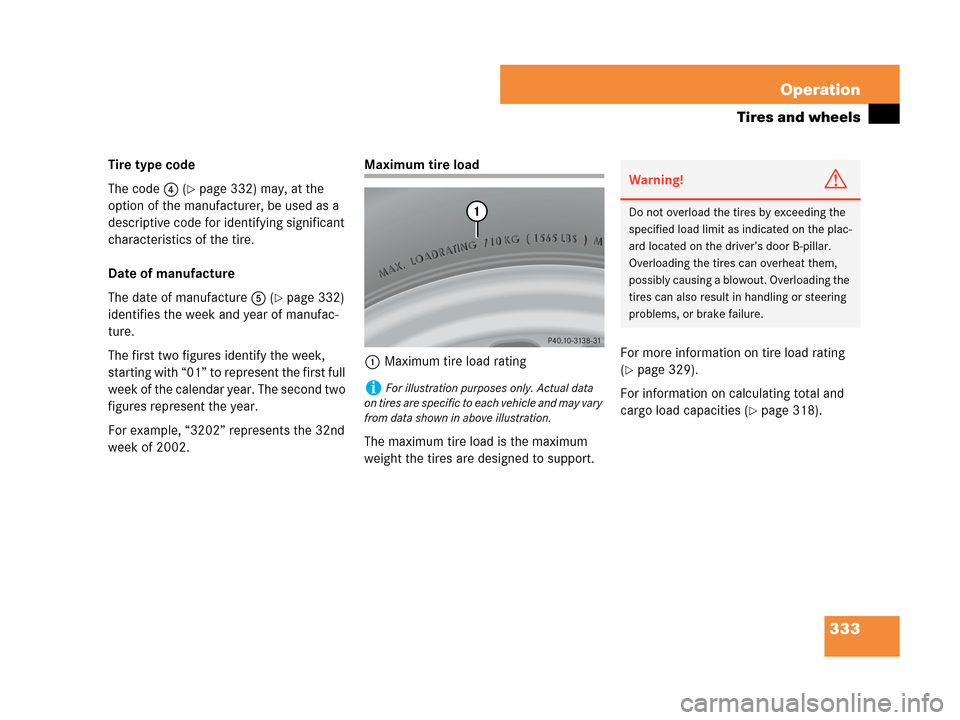
333 Operation
Tires and wheels
Tire type code
The code4 (
�page 332) may, at the
option of the manufacturer, be used as a
descriptive code for identifying significant
characteristics of the tire.
Date of manufacture
The date of manufacture5 (
�page 332)
identifies the week and year of manufac-
ture.
The first two figures identify the week,
starting with “01” to represent the first full
week of the calendar year. The second two
figures represent the year.
For example, “3202” represents the 32nd
week of 2002.
Maximum tire load
1Maximum tire load rating
The maximum tire load is the maximum
weight the tires are designed to support.For more information on tire load rating
(
�page 329).
For information on calculating total and
cargo load capacities (
�page 318).
iFor illustration purposes only. Actual data
on tires are specific to each vehicle and may vary
from data shown in above illustration.
Warning!G
Do not overload the tires by exceeding the
specified load limit as indicated on the plac-
ard located on the driver’s door B-pillar.
Overloading the tires can overheat them,
possibly causing a blowout. Overloading the
tires can also result in handling or steering
problems, or brake failure.
Page 338 of 481
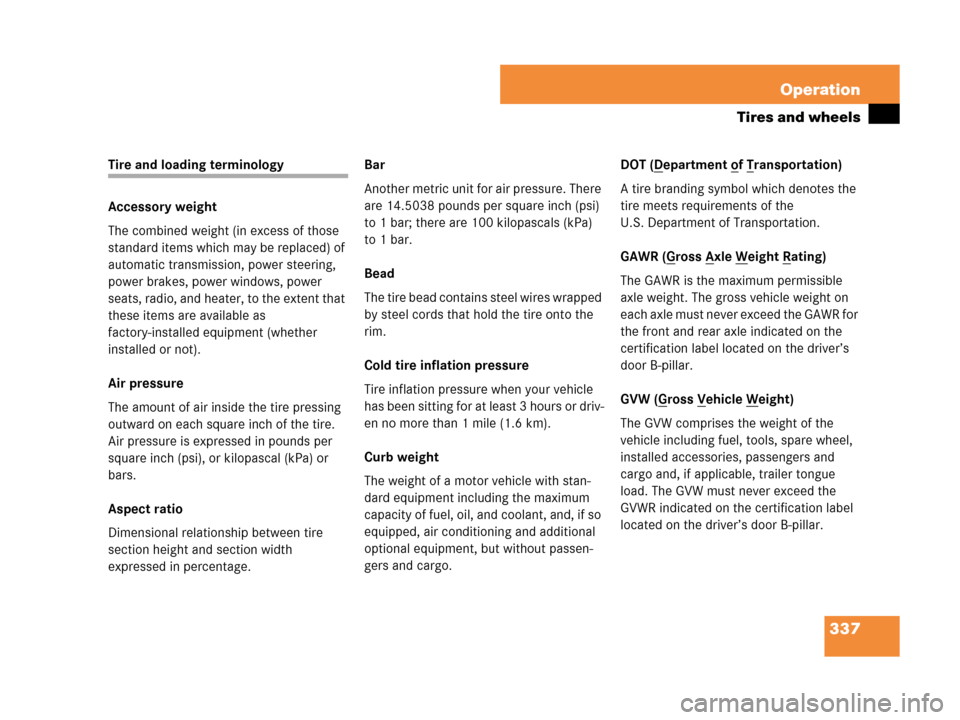
337 Operation
Tires and wheels
Tire and loading terminology
Accessory weight
The combined weight (in excess of those
standard items which may be replaced) of
automatic transmission, power steering,
power brakes, power windows, power
seats, radio, and heater, to the extent that
these items are available as
factory-installed equipment (whether
installed or not).
Air pressure
The amount of air inside the tire pressing
outward on each square inch of the tire.
Air pressure is expressed in pounds per
square inch (psi), or kilopascal (kPa) or
bars.
Aspect ratio
Dimensional relationship between tire
section height and section width
expressed in percentage.Bar
Another metric unit for air pressure. There
are 14.5038 pounds per square inch (psi)
to 1 bar; there are 100 kilopascals (kPa)
to 1 bar.
Bead
The tire bead contains steel wires wrapped
by steel cords that hold the tire onto the
rim.
Cold tire inflation pressure
Tire inflation pressure when your vehicle
has been sitting for at least 3 hours or driv-
en no more than 1 mile (1.6 km).
Curb weight
The weight of a motor vehicle with stan-
dard equipment including the maximum
capacity of fuel, oil, and coolant, and, if so
equipped, air conditioning and additional
optional equipment, but without passen-
gers and cargo.DOT (Department of Transportation)
A tire branding symbol which denotes the
tire meets requirements of the
U.S. Department of Transportation.
GAWR (G
ross Axle Weight Rating)
The GAWR is the maximum permissible
axle weight. The gross vehicle weight on
each axle must never exceed the GAWR for
the front and rear axle indicated on the
certification label located on the driver’s
door B-pillar.
GVW (G
ross Vehicle Weight)
The GVW comprises the weight of the
vehicle including fuel, tools, spare wheel,
installed accessories, passengers and
cargo and, if applicable, trailer tongue
load. The GVW must never exceed the
GVWR indicated on the certification label
located on the driver’s door B-pillar.
Page 339 of 481
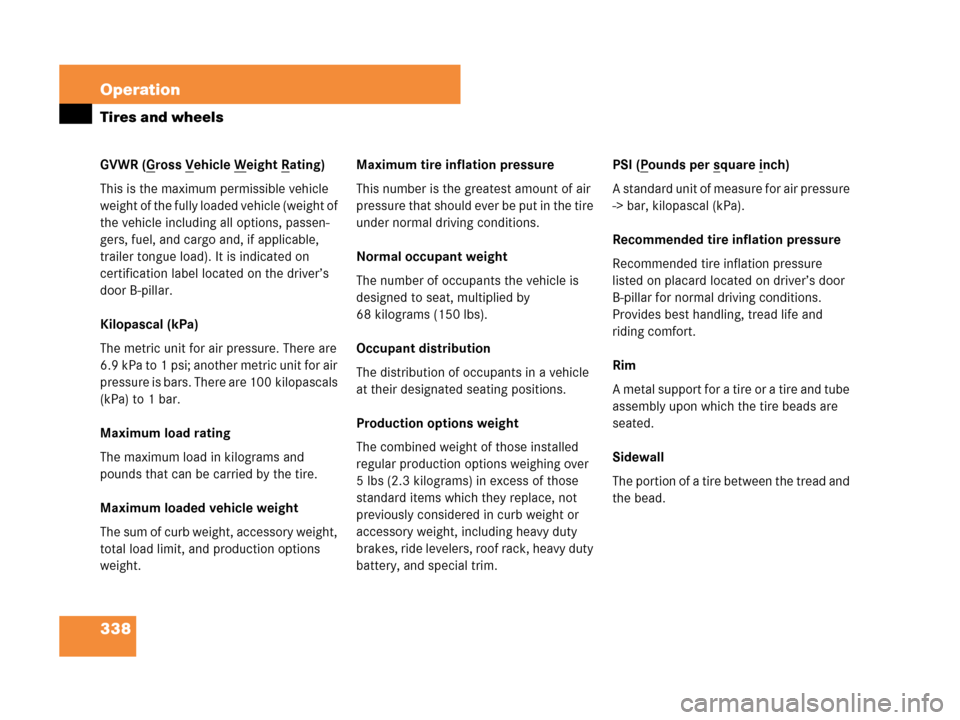
338 Operation
Tires and wheels
GVWR (Gross Vehicle Weight Rating)
This is the maximum permissible vehicle
weight of the fully loaded vehicle (weight of
the vehicle including all options, passen-
gers, fuel, and cargo and, if applicable,
trailer tongue load). It is indicated on
certification label located on the driver’s
door B-pillar.
Kilopascal (kPa)
The metric unit for air pressure. There are
6.9 kPa to 1 psi; another metric unit for air
pressure is bars. There are 100 kilopascals
(kPa) to 1 bar.
Maximum load rating
The maximum load in kilograms and
pounds that can be carried by the tire.
Maximum loaded vehicle weight
The sum of curb weight, accessory weight,
total load limit, and production options
weight.Maximum tire inflation pressure
This number is the greatest amount of air
pressure that should ever be put in the tire
under normal driving conditions.
Normal occupant weight
The number of occupants the vehicle is
designed to seat, multiplied by
68 kilograms (150 lbs).
Occupant distribution
The distribution of occupants in a vehicle
at their designated seating positions.
Production options weight
The combined weight of those installed
regular production options weighing over
5 lbs (2.3 kilograms) in excess of those
standard items which they replace, not
previously considered in curb weight or
accessory weight, including heavy duty
brakes, ride levelers, roof rack, heavy duty
battery, and special trim.PSI (Pounds per square inch)
A standard unit of measure for air pressure
-> bar, kilopascal (kPa).
Recommended tire inflation pressure
Recommended tire inflation pressure
listed on placard located on driver’s door
B-pillar for normal driving conditions.
Provides best handling, tread life and
riding comfort.
Rim
A metal support for a tire or a tire and tube
assembly upon which the tire beads are
seated.
Sidewall
The portion of a tire between the tread and
the bead.
Page 340 of 481
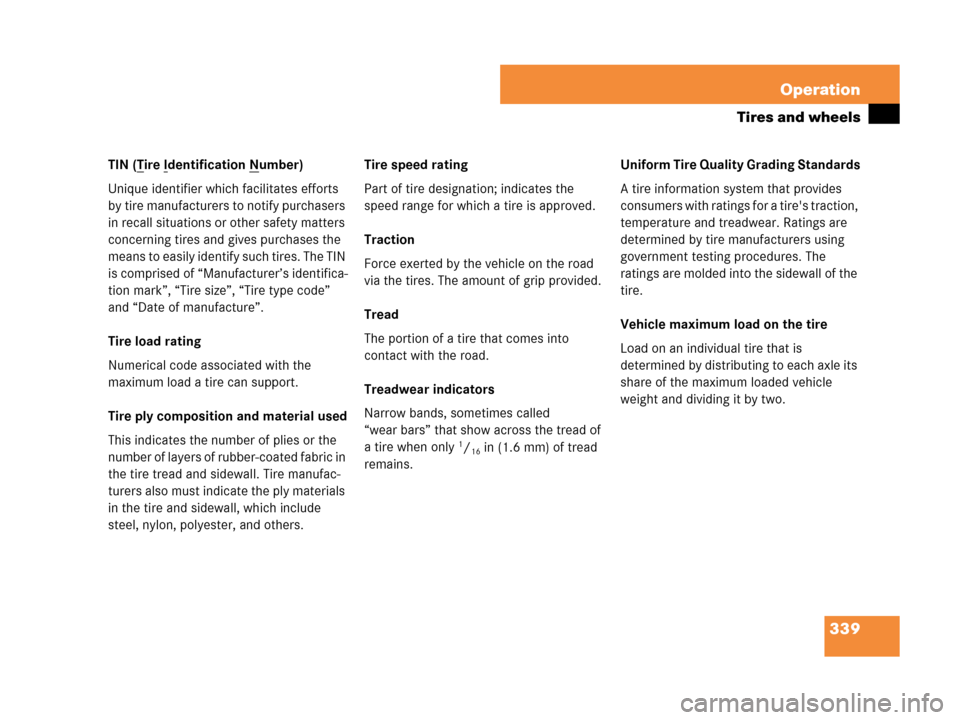
339 Operation
Tires and wheels
TIN (Tire Identification Number)
Unique identifier which facilitates efforts
by tire manufacturers to notify purchasers
in recall situations or other safety matters
concerning tires and gives purchases the
means to easily identify such tires. The TIN
is comprised of “Manufacturer’s identifica-
tion mark”, “Tire size”, “Tire type code”
and “Date of manufacture”.
Tire load rating
Numerical code associated with the
maximum load a tire can support.
Tire ply composition and material used
This indicates the number of plies or the
number of layers of rubber-coated fabric in
the tire tread and sidewall. Tire manufac-
turers also must indicate the ply materials
in the tire and sidewall, which include
steel, nylon, polyester, and others.Tire speed rating
Part of tire designation; indicates the
speed range for which a tire is approved.
Traction
Force exerted by the vehicle on the road
via the tires. The amount of grip provided.
Tread
The portion of a tire that comes into
contact with the road.
Treadwear indicators
Narrow bands, sometimes called
“wear bars” that show across the tread of
a tire when only
1/16in (1.6 mm) of tread
remains.Uniform Tire Quality Grading Standards
A tire information system that provides
consumers with ratings for a tire's traction,
temperature and treadwear. Ratings are
determined by tire manufacturers using
government testing procedures. The
ratings are molded into the sidewall of the
tire.
Vehicle maximum load on the tire
Load on an individual tire that is
determined by distributing to each axle its
share of the maximum loaded vehicle
weight and dividing it by two.
Page 367 of 481
366 Practical hints
What to do if …?
Lamp in center console
ProblemPossible cause/consequenceSuggested solution
56The front passenger front air bag
off indicator lamp illuminates
and remains illuminated with the
weight of a typical adult or some-
one larger than a small individual
on the front passenger seat.The system is malfunctioning.�Have the system checked as soon as
possible by an authorized
Mercedes-Benz Center.
�Read and observe messages in the
multifunction display and follow cor-
rective steps (
�page 372).
Warning!G
If the 56 indicator lamp illuminates
and remains illuminated with the weight of a
typical adult or someone larger than a small
individual on the front passenger seat, do
not have any passenger use the front
passenger seat until the system has been
repaired.
Page 368 of 481
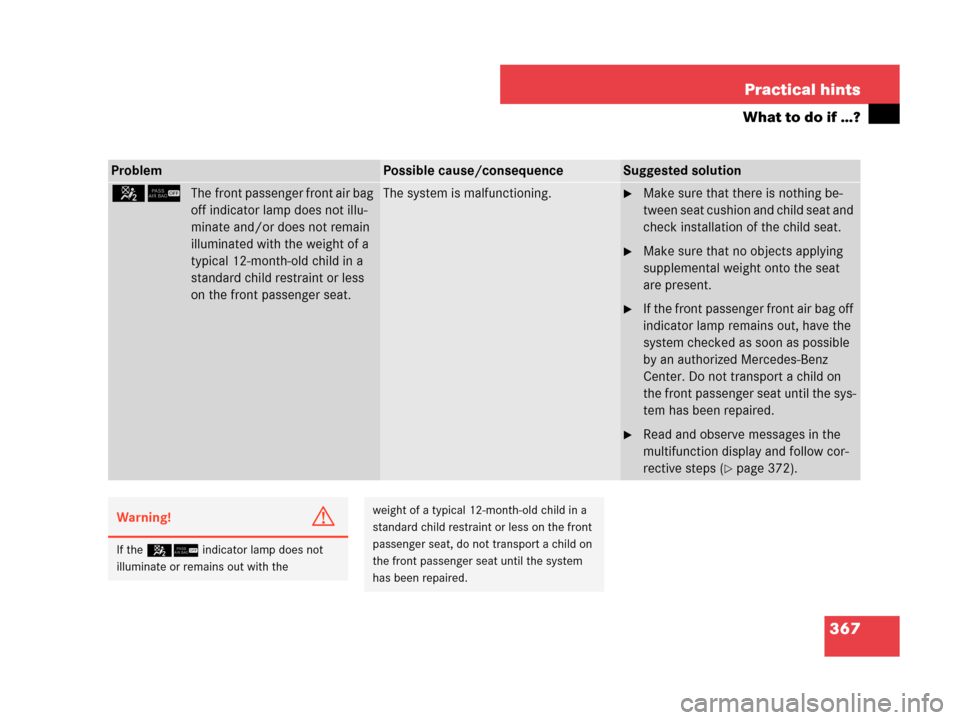
367 Practical hints
What to do if …?
ProblemPossible cause/consequenceSuggested solution
56The front passenger front air bag
off indicator lamp does not illu-
minate and/or does not remain
illuminated with the weight of a
typical 12-month-old child in a
standard child restraint or less
on the front passenger seat.The system is malfunctioning.�Make sure that there is nothing be-
tween seat cushion and child seat and
check installation of the child seat.
�Make sure that no objects applying
supplemental weight onto the seat
are present.
�If the front passenger front air bag off
indicator lamp remains out, have the
system checked as soon as possible
by an authorized Mercedes-Benz
Center. Do not transport a child on
the front passenger seat until the sys-
tem has been repaired.
�Read and observe messages in the
multifunction display and follow cor-
rective steps (
�page 372).
Warning!G
If the 56 indicator lamp does not
illuminate or remains out with the
weight of a typical 12-month-old child in a
standard child restraint or less on the front
passenger seat, do not transport a child on
the front passenger seat until the system
has been repaired.
Page 373 of 481
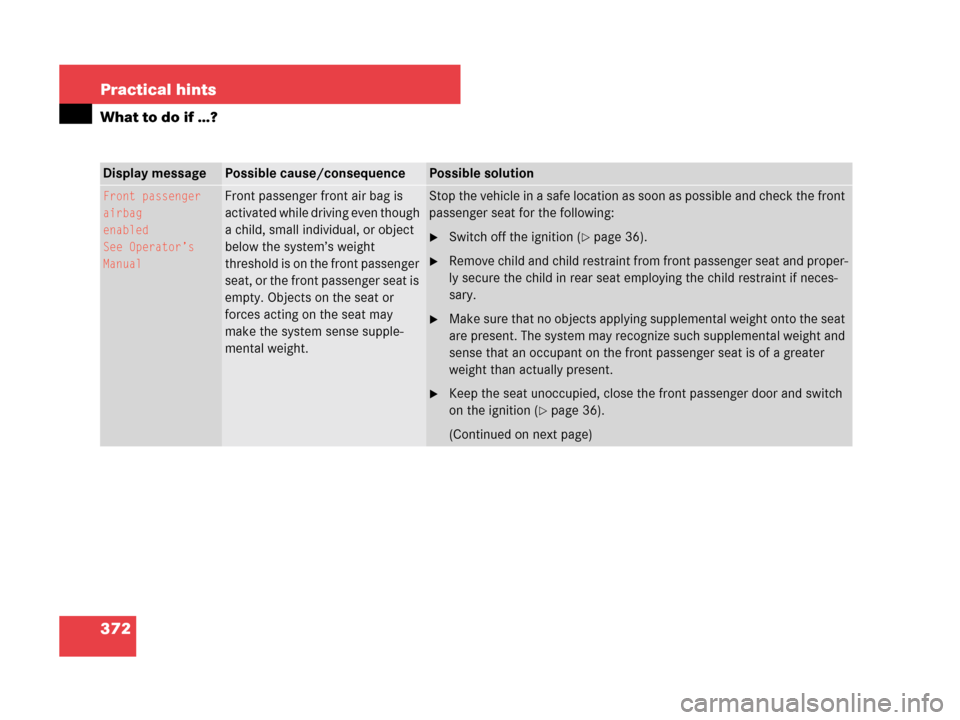
372 Practical hints
What to do if …?
Display messagePossible cause/consequencePossible solution
Front passenger
airbag
enabled
See Operator’s
ManualFront passenger front air bag is
activated while driving even though
a child, small individual, or object
below the system’s weight
threshold is on the front passenger
seat, or the front passenger seat is
empty. Objects on the seat or
forces acting on the seat may
make the system sense supple-
mental weight.Stop the vehicle in a safe location as soon as possible and check the front
passenger seat for the following:
�Switch off the ignition (�page 36).
�Remove child and child restraint from front passenger seat and proper-
ly secure the child in rear seat employing the child restraint if neces-
sary.
�Make sure that no objects applying supplemental weight onto the seat
are present. The system may recognize such supplemental weight and
sense that an occupant on the front passenger seat is of a greater
weight than actually present.
�Keep the seat unoccupied, close the front passenger door and switch
on the ignition (
�page 36).
(Continued on next page)
Page 375 of 481
374 Practical hints
What to do if …?
Display messagePossible cause/consequencePossible solution
Front passenger
airbag
disabled
See Operator’s
ManualFront passenger front air bag is deac-
tivated while driving even though an
adult or someone larger than a small
individual is occupying the front pas-
senger seat. Forces acting on the
seat may make the system sense a
decrease in weight.Stop the vehicle in a safe location as soon as possible and check the
front passenger seat for the following:
�Switch off the ignition (�page 36).
�Have the front passenger vacate the seat and exit the vehicle.
�Keep the seat unoccupied, close the front passenger door and
switch on the ignition (
�page 36).
(Continued on next page)